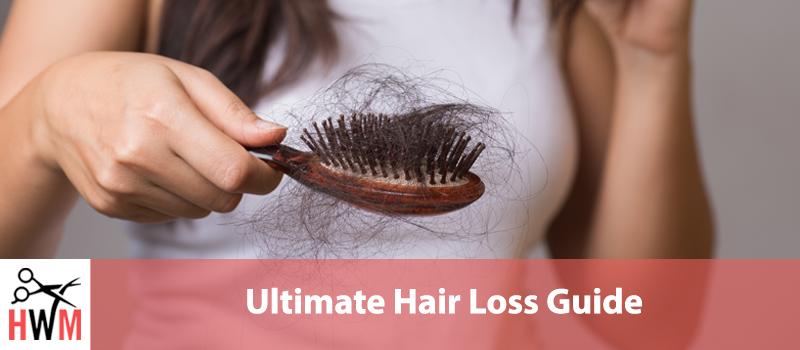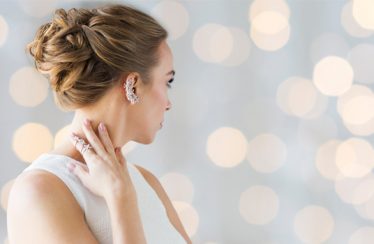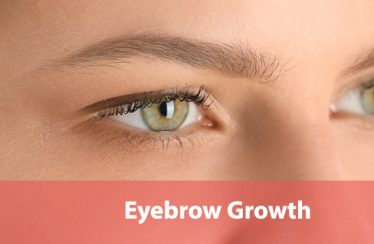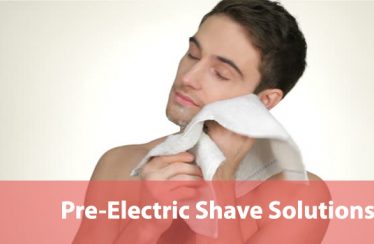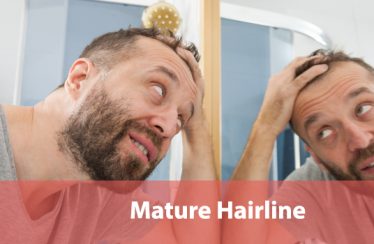Most of us are proud of our hair. We love the way it looks, and we spend a lot of time and money to keep it healthy and well-styled. It’s understandable that hair loss is upsetting. When you start to notice hair loss it can feel like you have no option or control over the situation.
Fortunately, we have more options to treat and manage hair loss now than ever before. Information is power. The more you know about hair loss and the treatment options, the more effectively you’ll be able to manage, and even reverse, your hair loss.
In this article, we’ll cover the most important information, from general information about hair loss, to what you can do when you first notice it. We’ll also cover the treatment options that are available right now, and some home and lifestyle changes you can make to help your hair recover.
This is meant to be a comprehensive article, so we may go over some information you already know if you’ve done other research on hair loss. Each section is self-contained, feel free to skip around or go straight to the section that’s most relevant for you.
Hair Loss Basics
Hair loss comes in a lot of different types and patterns. It also has several different causes, including both genetic and environmental factors. It may help to know that most people will experience some degree of hair loss in their lives. Some hair loss is even a natural part of aging, while other forms start when you’re young.
In this section, we’ll cover several different types of hair loss, and the most common patterns hair loss can take. We also address common causes of hair loss and talk about when hair loss might be a cause for immediate medical concern.
If you’re looking for information about what you can do when you first notice hair loss, or to learn about different treatment options, we’ll cover those topics a little further down.
Types of Hair Loss
You’ll probably need to go to a doctor or dermatologist to find out for sure which type of hair loss you have. But, knowing what each type is, and how it affects your hair and your hair loss, can help you treat your hair loss more effectively.
Androgenic Alopecia, sometimes just called alopecia, this is the most common form of genetic hair loss. You might also see this form of hair loss called male or female pattern baldness.
Androgenic alopecia is largely dictated by the presence and concentrations of androgens in your body. You’re probably most familiar with the term androgen from your high school sex-ed course, but androgens have effects throughout your body.
Androgens are male sex hormones, although everyone has some amount of androgens. Women typically have a lower concentration of androgen, and the type and concentration of androgens in your body can change as you age, and even through the day.
One of the most important androgens when it comes to hair loss is dihydrotestosterone or DHT. DHT is a more bioactive form of testosterone, and most men will naturally produce more DHT as you age.
DHT isn’t all bad and can help you grow better facial hair, but it damages the hair follicles in your scalp. Over time, that damage causes the hair follicles to shrink, until eventually, they can’t grow hair at all.
Androgenic alopecia is progressive, and you’ll lose more hair the longer you leave it untreated. However, it’s different in everyone. Some men lose most of their hair, others will see some thinning but keep their hairline and most of their hair.
Your mother’s male relatives are the best predictor of androgenic alopecia since most of the genes that cause it are passed down on the X chromosome. If your maternal grandfather and uncles all have some hair loss, chances are you will too.
Telogen Effluvium refers to when in your hair’s natural growth cycle it’s being shed. Telogen Effluvium can have many causes, but knowing when your hair is falling out can help you treat it more effectively.
Telogen effluvium comes in two main forms, chronic recurring telogen effluvium is a more permanent form of hair loss, while basic telogen effluvium can be caused by situational and environmental factors and is often reversible. You may not even need treatment to see your hair grow back, depending on the cause.
Telogen is the resting phase for your hair follicle. Hair that is lost in the telogen phase would have eventually fallen out anyway, to make room for a new strand of hair to grow when the follicle goes back into the anagen, or growth, phase.
Telogen effluvium can be a sign of genetic hair loss, high stress, or a response to medical stress. We’ll talk more about possible causes a little further down.
Anagen Effluvium is a more concerning form of hair loss. Anagen is the active growth phase of hair, so it takes a more severe stressor to cause your hair to shed in anagen. You probably won’t be able to tell the difference between anagen and telogen effluvium on your own.
Your dermatologist or doctor will probably ask you some questions about your recent medical history and may ask about recent events or changes to help determine what is causing your hair loss.
Your doctor will probably also order some additional testing since anagen effluvium can have both medical and situational causes. It’s important to know all of what’s causing the hair loss, so you can effectively treat the underlying cause as well as the symptom.
Traction Alopecia is hair loss resulting from chronic tension on your hair, or other forms of chronic damage. It most common in people who habitually wear tight hairstyles like braids and cornrows, or who consistently wear ‘up do’ looks that put a lot of tension on your hair’s roots and follicles.
This form of hair loss is mostly related to scar tissue. High-tension hairstyles, and even cuts and bruises that scar, cause scar tissue to build up on your scalp. Over time, that scar tissue can prevent nutrients and oxygen from getting to your hair follicles. Scar tissue also takes up more room than regular skin.
You can also get traction alopecia from consistent chemical damage. Allergic reactions, chemical relaxers, lots of heat-styling near your scalp, and other damaging habits can all contribute.
As scar tissue builds up it forces your hair follicles to shrink, and, like damage from DHT, eventually, your hair follicles aren’t able to grow hair at all.
Fortunately, traction alopecia is one of the most treatable forms of hair loss. You might not be able to get truly all your hair back, especially if your traction alopecia has been progressing for a while. But, it’s easily reversible if you catch it early.
Other, these aren’t the only types of hair loss out there. Other forms of hair loss, like severe breakage that mimics hair loss without involving your hair follicles, will still probably take a dermatologist to diagnose.
These other forms of hair loss are also rarer. Chances are, if you have hair loss, you have one of the types we’ve already discussed. Other forms of hair loss require diagnosis and can require specialty treatments and management.
Hair Loss Patterns
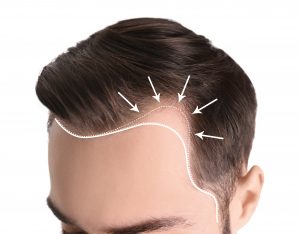
There are several common hair loss patterns. Some of these patterns are more common with specific types of hair loss, but you can experience almost any pattern of hair loss with all the main forms of hair loss.
Where you’re losing hair can make a difference in how you treat it, for instance, Rogaine is more effective for hair loss on the crown of your head than it is for a receding hairline, though it’s used for both.
Receding Hairline, this is one of the most common forms of hair loss in men and one of the most distressing. Women aren’t very prone to this hair loss pattern.
It’s one of the patterns commonly associated with androgenic alopecia and with traction alopecia, although it can be caused by other forms of hair loss.
We’re differentiating this type of hair loss from the type that pulls back over the temples and causes a widow’s peak. When we say receding hairline, we mean a generally receding hairline that is as thin or thinner near your forehead as it is near your temple or ears.
This form of hair loss is easier to catch early, but it’s also difficult to treat. You may have to try multiple types of treatment to get good results. Fortunately, once you start treatment you can usually slow or stop this hair loss pattern from progressing.
Balding Crown, otherwise known as a bald spot, is another common hair loss pattern in men suffering from androgenic alopecia.
Fortunately, this is a highly responsive area of your scalp. Usually, this hair loss pattern is easy to reverse, if you catch it early enough. The biggest problem with this hair loss pattern is that it can be hard to spot on yourself.
If you’re concerned you might develop this pattern, especially if you have relatives with bald spots, you should as a trusted friend or family member to check your hair. The sooner you can catch the signs of a balding crown, the more likely you are to be able to reverse the hair loss.
Diffuse Hair Loss refers to hair loss that isn’t concentrated in any particular area or is concentrated in multiple patches through your scalp. Diffuse hair loss is more common in women than men, but men are more likely to get it as you get older.
Diffuse hair loss is often hard to spot early since you have to lose a significant amount of hair before there is a visible difference.
There are a lot of causes for diffuse hair loss for some people it’s highly reversible and incredibly stubborn for others. You should make a dermatologist appointment and plan to work with your dermatologist for a while if you suspect you have this hair loss pattern.
Widow’s Peak, is another common form of hair loss in men. This is technically a form of a receding hairline, but the hair loss is concentrated at or slightly above your temples.
If you’re developing a widow’s peak, there’s good and bad news. The good news is that this is an incredibly common form of hair loss. A mild to moderate widow’s peak hairline can be very attractive and may not need treatment at all.
Unfortunately, the bad news is that the area around your temples is another tricky spot to effectively treat. If you catch the issue early you can potentially prevent your hair loss from progressing. But, to truly regrow hair you may need to choose more aggressive treatment options or hope that you are highly responsive to topical and prescription treatments.
Common Causes of Hair Loss
There are lots of causes of hair loss. Some of them are in your control, while others are genetic and will probably kick in at some point. For instance, the most common cause of hair loss in men is a genetic predisposition to hair loss.
But, even without treatment, you can make your hair loss worse if you combine your genetic risk factors with other causes of hair loss. And you might be able to mitigate some of your hair loss by fostering good habits and avoiding common risk factors.
Genetics, the most common genes for hair loss pass down on your x chromosome. We’ve already mentioned that looking at your mom’s male relatives can be a good predictor for these genes, but you can also look at other relatives for genes that influence your hair.
For instance, while hair loss might come from your mom, your hair color, texture, and thickness, can come from either parent. The thickness you start with, or the density of hair per inch of scalp can influence how your hair loss presents.
If you start with more hair, you have more opportunities to catch and reverse hair loss.
So, pay attention to your relative’s hair, especially relatives with similar hair color, texture, and density. They might be a good predictor of how your hair loss will look and progress. They can also be a good indicator for which treatments work if they’ve found a good hair loss treatment for them.
Chronic Stress, or High/Traumatic Stress Incidents, can both be major risk factors for hair loss. It’s not uncommon to notice some temporary hair loss a few months after a car accident, surgery, or the death of a loved once.
But you may also see progressive hair thinning, particularly diffuse hair thinning if you endure chronic stress at home or work. Even if you’re used to the stress it can have big effects on your metabolism and circulation.
Since your hair follicles are sensitive and non-essential parts, they can be damaged and stop working even before you see other health effects from stress.
Tight Hair Styles and Harsh Styling, we already talked about this common cause a little in the section on traction alopecia, but it’s worth mentioning again. Harsh styling and tight hairstyles can contribute to hair loss, even if you don’t have traction alopecia.
As a general rule, if you like tight hairstyles, cornrows, up-dos, or consistently use a lot of product or hot-styling tools, you should try to take breaks from those hairstyles. Opt for looser alternatives, regardless of which type of hair loss you have, and your scalp will thank you.
Smoking is another common risk factor for hair loss. It can cause hair thinning even in people who don’t have genetic pre-dispositions to hair loss.
There are a couple of reasons that smoking can be problematic. Your hair follicles need a steady supply of oxygen to keep working, but smoking can interfere with your oxygen supply. While you’re smoking, you’re getting less oxygen than normal, since the smoke is replacing a significant amount of the air you would get in a normal breath.
As lung damage from smoking adds up, you’ll also have a slightly lower blood oxygen rate, which can affect your whole body, not just your hair.
Nicotine and other chemicals from traditional cigarettes are also more directly harmful to your hair. The chemicals in your smoke diffuse into your blood just like oxygen does. Your hair follicles are sensitive to a lot of those chemicals, which can damage and shrink them just like other types of damage.
It’s unlikely that smoking can cause significant hair loss on its own. But, it can damage your hair and your hair follicles. If you already have hair loss, smoking can make it worse.
Smoking can also make it harder to treat your hair loss since most successful treatment options rely on repairing your hair follicles and smoking damages them again.
Not Getting Enough Sleep is another common risk factor for hair loss. Sleeping is important to maintain metabolic health, keeping stress levels low, and having enough can even help you make and keep good diet and exercise habits.
It shouldn’t be a surprise that your hair can start to thin if you don’t get enough sleep. But the importance of sleep is hard to overstate. And, right now, it’s easy to short yourself and sleep and lean on coffee, energy drinks, and supplements to keep you going.
And while coffee is a great topical hair booster, it can’t replace sleep when it comes to supporting hair growth.
Like smoking, being chronically sleep-deprived may not be enough to cause hair loss by itself, but it can certainly make your existing hair loss worse and make it more difficult to treat your hair loss.
Diet is hugely important. While hair loss is unlikely to be the only side effect of a poor diet, living off frozen dinner and energy drinks is bound to affect your hair.
Eating healthy foods, particularly foods with healthy fats and oils like nuts and fish, has a direct impact on the health of your hair follicles.
Other Disorders: Unfortunately, there are plenty of disorders and health problems that can cause hair loss. Thyroid issues are a common cause of hair loss, but scalp psoriasis, some types of auto-immune disorders, and plenty of others can also contribute.
There are too many disorders that potentially come with hair loss to list them all here. Chances are, if you have already been diagnosed with a disorder likely to cause hair loss, your doctor already talked to you about the possibility.
But, the prevalence of hair loss with auto-immune and hormonal disorders makes it especially important to see your doctor when you notice hair loss.
Even if you’re planning treatment through a dermatologist, you should see a doctor as well, just to stay safe.
When Hair Loss is Concerning
Of course, not all hair loss is normal. You should plan a visit with your doctor when you notice hair loss, even if you knew you were likely to get hair loss. But there are some signs that your hair loss may be a more serious concern, and if you have any of these you should make an appointment as soon as possible.
None of these are concerning enough to make a trip to the ER, but you should plan an appointment with your primary care physician. If you can’t get in quickly, ask to consult with a nurse practitioner or other available professional in your doctor’s office for advice and next steps.
It’s Very Sudden: If you notice that you have significant, visible, hair loss, all coming on within a few weeks, that’s a concerning form of hair loss. Some anagen effluvium can present this way, but it’s almost always a worrying development.
Hair loss usually develops over months and years, so if it comes on quickly, you should consult with a doctor.
It’s Patchy: If you notice that you’re losing hair from specific patches of skin, but not elsewhere, that might be a cause for concern. Especially if your patchy hair loss comes on suddenly, or you feel like chunks of hair are falling out when you brush or shower, you should make an appointment right away.
You’re also Losing Body and/or Facial Hair: Hair loss is usually concentrated on your head and scalp. If you notice that you’re getting hair loss elsewhere as well, especially from your eyebrows or eyelashes, you should see your doctor.
One exception to this is if you’re taking medication, like chemotherapy, that is known to cause hair loss. In that case, you should check to see if this pattern of hair loss is normal, and let your doctor know at your next scheduled visit.
But if you don’t know what the cause is and you’re losing hair from your face, arms, legs, or anywhere but your scalp, you should seek care right away.
First Steps When You Notice Hair Loss
When you notice hair loss you may feel helpless, but there are some things you can do right away that will help the health of your hair and give you some peace of mind.
Stay Calm
It’s natural to feel upset or panicky when you first realize you’re experiencing hair loss. But, it’s important to try and stay calm. If you need to, take a step back (and away from the mirror) and do something you enjoy until you feel calmer.
Ultimately, freaking out about hair loss doesn’t help your hair come back, and too much stress can make your hair loss worse.
Remember that you have a lot of options to take care of your hair loss and that most hair loss is normal and common. Almost everyone will experience hair loss to some degree.
It’s also a good idea to remember that you can be just as attractive after hair loss as you were before. Confidence is more important than any single feature.
Try to make decisions about your hair loss, and the treatments you try, when you’re calm, even if that means delaying those decisions for a while. A few days, or even weeks, won’t make a huge difference in your results, but it can make a big difference in the quality of the decisions and the treatments you pursue.
When you’re ready, here are a few things you can do right away to access your hair and to improve its health and thickness.
Self-Check Your Hair
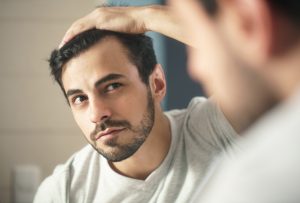
There are some things you can do at home to assess your hair loss right away. The information you get from checking your hair will also be useful for your doctor or dermatologist.
Do you notice differences in your hairline?
This is one of the most common first symptoms of hair loss. Even if your hairline hasn’t pulled back or changed shape, you might be able to see other changes in your hair.
The most obvious difference will be if the hair above your temples or over your forehead is pulling back. But the hair in those areas may also be thin, making it easier to see your scalp.
You could also notice that you have more vellus, or baby, hairs in those areas.
If the hair along your hairline is a noticeably different color or texture, that can also be a sign of changes to the health and thickness of your hair.
Even if your hairline is normal, you should still check your hair in other ways. You’ll have more information and may even feel better about the health of your hair.
Perform a Hair Fall Test
Hair fall tests are easy to do and can give you a lot of information. Simply grab a small section of your hair. About an inch diameter section is plenty big. Apply gentle pressure and pull your hair, sliding your fingers down from the root to the tip.
You don’t need much pressure for this test. It should be comfortable. If pulling your hair hurts is uncomfortable, you’re pulling too hard and should start over with a different section of hair.
Aim for just enough pressure to hold on to the strands of hair that comes loose. Some hair should come loose. 1-5 strands is normal, and just part of the normal grow and shed cycle your hair is always in.
Count the strands. If you have more than 5, that’s a sign that you’re losing hair. More than 10-12 strands might warrant more immediate attention. You should make an appointment with a doctor to make sure there isn’t some other health issue causing your hair loss.
Check for Damage at the Ends
This step checks for the overall health of your hair. Damaged ends don’t necessarily mean hair loss, everyone gets split ends after all, but if you have a lot of damage that could contribute to your hair loss.
Damaged hair is also a good indicator that your shampoo or conditioner might need to be changed, or that you’re not getting all the nutrients you need from your diet.
This step is easiest if you have long hair. If you have short hair you might need to ask a friend or family member to inspect it for you.
You’re looking for split ends, small white dots along the hair strand, or a dry crinkly feeling, especially in the last inch of your hair.
Mild to moderate damage might just be a sign that you need to get a trim, but if your hair seems especially damaged, or is showing more than one of those symptoms, it might be time to take a trip to your dermatologist.
Check for Texture or Color Changes
Just like changes to the texture or color of the hair along your hairline can be an indication of hair loss, the same signs in the rest of your hair can also signal a problem.
If your hair seems dull and lifeless, that’s a sign of ill health. If the color seems to get darker, or less varied than before, it usually means something is going wrong with your hair follicles, or your hair care products are causing damage.
If your hair suddenly seems thinner and curlier, that might mean follicle damage, especially if it’s thinning at the same time.
You can probably see these differences in a regular mirror, without help. But you should also run your fingers through your hair and see if it feels dry, stringy, or thinner than usual.
Make an Appointment with a Doctor or Dermatologist
One of the simplest and most effective early interventions you can make is making an appointment with your doctor or dermatologist to check out your scalp and hair. They’ll be able to diagnose the problem and make the best suggestions for treatment.
You can also continue working with your doctor and dermatologist for the long term, to make sure you continue getting good results.
Depending on the cause of your hair loss, it may also be worth making an appointment with a dietician to make sure you’re getting all the nutrients and vitamins you need for healthy hair.
Check (and Change) Your Shampoo and Conditioner
Your shampoo and conditioner can make a huge difference in the overall health of your hair. Most shampoo is safe and healthy for most people, but if you have sensitive skin, have hair loss, or are looking for specific benefits, you may need to change products to get good results.
There are some general things to look for and avoid. We’ll talk ingredients in a moment, but in general, you should use a hair loss or moisturizing shampoo, and avoid clarifying shampoos.
Clarifying shampoos tend to be harsher than other types of shampoo. They use more drying ingredients and are slightly more likely to irritate your scalp.
You should also avoid 2-in-1 shampoo and conditioner products. 2-in-1 products combine a shampoo, which is supposed to wash completely away, with conditioner, which is supposed to leave some protective and moisturizing ingredients on your hair.
The 2-in-1 formula can’t control which ingredients wash away, and which stay on your hair.
Ingredients to Avoid
In addition to avoiding those types of shampoo, there are some ingredients that you should avoid in all shampoo. These ingredients are all incredibly common, so it’s unlikely that you’ll be able to get rid of all of them. Instead, try to find a shampoo with lower concentrations of each ingredient.
The easiest way to find low concentrations is to read the ingredient list. The further down the list these ingredients appear, the better.
You can also minimize how many of these ingredients are included, even eliminating one or two can be a benefit to your scalp.
Sulfates: Sulfates are commonly added to increase the amount of lather your shampoo produces. Unfortunately, they can be irritating for some people and are a drying ingredient in general.
The good news is that sulfates are one of the easier ingredients to avoid. Shampoos that are formulated without sulfates usually advertise it, so you don’t have to read the ingredient list. Just look for a sulfate-free label or stamp.
Parabens: Like sulfates, parabens can be one of the easiest shampoo ingredients to avoid. A lot of shampoos that are sulfate-free are also paraben-free.
Parabens are a common preservative ingredient. The main concern with parabens is that they are thought to disrupt normal hormone function and balance. If you have sensitive skin, they may also be irritating.
Sodium: Sodium can appear in shampoo in a few different forms. Sodium is one of the chemicals in common sulfates, like sodium lauryl sulfate. It might also be included in several different salts, including table salt, where it acts as a thickener in your shampoo.
Sodium is a drying harsh ingredient. Chances are you won’t be able to completely avoid this one, so instead, look for shampoos that have sodium-containing ingredients further down the ingredient list.
Alcohol: Some amount of alcohol is likely unavoidable in your shampoo. Fortunately, there are several types of alcohol that can be good for your hair in low concentration.
Look for alcohols like cetyl and stearyl alcohol that start with an S or a C. Avoid alcohols that start with other letters, as a general rule.
You should also look for a shampoo with no alcohol at all in the first 4 ingredients on the list. Even S and C alcohols that can be good for your hair are harsh and drying if the concentration in your shampoo is too high.
Ingredients to Look For
Conversely, there are some ingredients that we know are great for your hair and scalp. It’s unlikely that you’ll find a shampoo that includes all of them, but if you look for the top two or three that matter most for you, you’ll be in good shape.
Ketoconazole: Ketoconazole is an anti-microbial that works to keep the microbes on your scalp in a healthy balance. It’s particularly good if you have a consistently irritated scalp. By bringing the yeast and bacteria on your scalp under control, this ingredient improves your overall scalp health, which helps your hair.
Salicylic Acid: Salicylic acid is a common ingredient in acne-fighting cleansers and skin products, but it’s great for your scalp too. Salicylic acid works by going into your pored and breaking down the clogs. It breaks up dried glued-together skin and kills bacteria.
Clearing the obstructions in your pores and lifting more the dead skin off your scalp leads to healthier skin. Since salicylic acid goes into your pores, it can also potentially help other skin and hair-boosting ingredients penetrate further into your skin.
Better penetration makes topical treatments more effective.
Caffeine: Caffeine has been shown to help with hair growth in a couple of ways. It encourages the follicle to go into growth phases earlier, can help your hair grow faster, and can make it grow stronger and healthier.
Some of this is just the effect of the caffeine directly on your hair follicle, but it also has another important action. Caffeine can interfere with the action of DHT, breaking it down and protecting your hair follicles from DHT damage.
You get some benefit from drinking coffee, but drinking too much coffee or soda and energy drinks can have negative consequences. Caffeine in shampoo and other hair products can help boost your hair growth without the negative consequences from drinking too many sugary drinks.
This isn’t a complete list, of course. Natural oils, peppermint, eucalyptus, selenium sulfide, and many other ingredients can also be a huge benefit to your hair.
Look for moisturizing shampoos, shampoos designed specifically for hair loss, or volumizing and thickening shampoos.
Treating Hair Loss
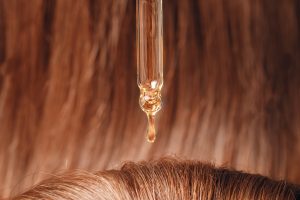
Of course, if you have or suspect that you have hair loss, you want to know what you can do to treat the issue and keep your hair. As we said in the introduction, there are more options to treat hair loss today than there have ever been before.
You may need to combine multiple treatments and other hair loss tips and tricks to get good results, but chances are, something on this list will work for you.
Play to Your Diagnosis
The best thing you can do is get an accurate diagnosis. Ask your dermatologist about what type of hair loss you have. Ask them how advanced your hair loss is, and how long you’ve likely had it.
They might not be able to give you all the answers, but they have valuable information that will help you treat your hair loss.
Once you have a diagnosis, target your treatments to that diagnosis.
If you have androgenic alopecia, talk to them about topical and prescription treatments, and prioritize treatments that help lower DHT.
If you have traction alopecia, change your hairstyle and prioritize treatments that will help reduce scar tissue and restore circulation.
Your diagnosis doesn’t mean you’re doomed to lose your hair. Think of it as another tool in your toolbox, one you can use to help keep and protect your hair.
General Tips and Tricks
These general tips and tricks are helpful for people who have hair loss and people who don’t. All of these will help keep your hair and scalp healthy, which is all to the good.
Don’t Wash Your Hair Too Often (or Too Little)
One of the most common mistakes people make is washing their hair too often. Even the best product can dry and damage your hair and scalp if you use them too often.
Most people only need to wash their hair every few days. There are some exceptions, of course, but unless you know that your hair gets greasy and dirty incredibly quickly, it’s worth trying to wait a day or two between rinses.
Your skin doesn’t need a shower every day either. But, if you enjoy taking a shower, you can still take a shower every day, and just avoid getting your hair wet unless you intend to wash your hair.
Washing your hair too little can be just as problematic since dirt and debris building up on your scalp can cause unhealthy levels of bacteria and yeast. Try washing every other day for a week. If your hair still looks and feels good, try washing every third day.
Some people can go longer than 3 days with perfectly healthy and happy hair, washing as little as once a week. But for most, 3 days is the norm before your hair is too dirty or greasy.
Play around with timing until you have a schedule you like, and that works for your hair specifically.
Get a Silk or Satin Pillow Cover
Your pillow cover can also have an impact on how much hair stays on your head. Your hair can get stuck in the weave of the fabric and pull and break. Too much oil can build up on your pillowcase and transfer back onto your hair and scalp.
Switching to a silk or satin pillow cover preserves your existing hair. It causes less damage since the weave of the fabric is fine enough that your hair won’t get tangled in the fabric. Even if your old pillow cover doesn’t pull hair out through the night, it likely still damages it as your hair gets tugged and pulled by the fabric.
Silk and satin fabrics also tend to show oil and dirt, giving you a clear reminder when you should wash your pillowcase. Most people should wash their pillowcase every week for optimum hair health, although some people may need to wash their sheets more often.
Avoid Tight Hairstyles
We’ve already talked a little about right hairstyles in the sections on traction alopecia and hair loss risk factors. But, since traction alopecia is one of the leading causes of hair loss, particularly among people of color, it’s worth bringing up again.
Tight hairstyles, updos, and even protective hairstyles that put a lot of pressure on the roots of your hair, all cause progressive damage to your hair follicles. If you don’t give your hair breaks between tight hairstyles, that damage adds up and can cause and contribute to hair loss.
You should also avoid harsh chemicals like relaxers, bleach, blonde hair dye (which is bleach), and other chemical styling tools.
Massage Your Scalp
Massaging your scalp is another simple way to bring circulation, and therefore oxygen and nutrients, to your hair follicles.
Gentle scalp massage is best done with the pads of your fingers, or a specialized tool designed to be soft without grabbing your hair or being too abrasive.
You can massage your scalp before bed, when you wake up, in the shower, or as part of your morning hygiene routine.
Grow Your Hair Back
This section is dedicated to the interventions and treatments you can use to grow your hair back. The other tips and tricks in this article may help you grow your hair back and will help you create ideal conditions for hair growth, but this section is where the magic happens.
What You Can Expect From Hair Loss Treatments
Regardless of what treatment or treatments you use, growing your hair back takes time. With all these treatments, you should expect it to take 3-4 months to start seeing results. That’s because the hair on your scalp grows in a several-year cycle, and every treatment must work with the natural growth cycle to grow your hair.
You should also know that it can take even longer to see your final results. Your hair will likely continue to grow for the next 6-12 months after you begin treatment.
Almost all of these treatments will also lose some effectiveness after a few years. If your hair loss is progressive, your treatment resets the clock and slows the progression, but you will still lose some hair as you age.
For most people, additional hair loss after beginning (and continuing) a treatment is minor. You may see a slightly visible decline, but usually, your hair will stay mostly the same if you continue treatment.
Let’s take a look at your treatment options.
Propecia, aka, Finasteride
Propecia is the brand name of Finasteride, a prescription drug that helps to fight hair loss. Propecia is only approved for use in men, and the pills should not be handled by women or children.
Propecia is an FDA approved treatment, and it works for the vast majority of men who use it.
It works by targeting one of the main hormones behind most varieties of hair loss. DHT, dihydrotestosterone. Finasteride treatments have been shown to reduce the concentration of DHT in your body by as much as 70%. It does increase the amount of testosterone in your system slightly since it isn’t turning into DHT. But, your testosterone levels still stay well within normal healthy ranges.
Propecia is also used as a treatment for an enlarged prostate and will have some effect on your prostate even if you’re using it primarily as a treatment for hair loss.
You should always make sure your doctor knows you’re taking Propecia or generic Finasteride. That way they can take the medicine into account when running blood work or performing a prostate exam.
Your insurance may cover the cost of Propecia or a generic. However, it’s more common for insurance companies to refuse to cover the costs because it’s easy to tell when Finasteride is being used for hair loss.
The required dose to treat hair loss is significantly smaller than the dose to treat prostate problems. So, your insurance may deny coverage since it’s considered an elective cosmetic procedure.
Rogaine, aka, Minoxidil
Rogaine is one of the oldest FDA approved treatment for hair loss. Rogaine is the brand name for Minoxidil, which is the only topical hair loss treatment that has received FDA approval.
Minoxidil, like Finasteride, works well for most men, although it does have slightly lower success rates. You also have to make time to apply it every day and may need to apply it twice a day for best results.
You can use Minoxidil and Finasteride together, and your doctor may recommend doing so since they have a synergetic effect used together.
Synergy refers to the effect or two medications combined being greater than just the two medications combined should be. So taking Finasteride and applying Minoxidil is one of the most effective ways of bringing your hair back from hair loss.
Rogaine comes in two strength formulations, 2%, and 5%, but the 5% is proven significantly more effective. We recommend the 5% because there’s no reason to buy a several month supply of the weaker formula, only to discover that it isn’t giving you the results you want.
You can also buy it in two application formulas, a serum, and a foam.
The foam is significantly easier to apply and can help prevent the medication from running down your forehead or onto the top of your ears, where it can cause unwanted hair growth.
But the serum can be easier to get directly onto your scalp where it will do the most good.
The most common side effect of minoxidil, either Rogaine or generic alternatives, is scalp irritation. For most men, the irritation from Rogaine is mild and tolerable, although if you start noticing a rash, or the sensation is too intense, you should consult with a doctor before you continue using it.
Once you start using Rogaine you also need to continue using it. If you stop, all the hair you have as a result of Rogaine use will fall out within 6 months.
Hair Transplants
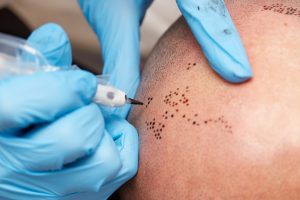
This is a more permanent alternative than either Rogaine or Finasteride, but hair transplants are also more invasive.
Depending on the type of hair loss you have, you also may not be a good candidate for hair transplants, so you should consult with your dermatologist if you’re considering this treatment option.
Your dermatologist will probably also recommend either Rogaine or Propecia in addition to the hair transplant, after the transplant has healed, to help maintain hair follicle health.
There are two basic types of hair transplant. In the older transplant style, your doctor will cut a small section of skin from the back of your head, somewhere your hair will easily hide any scarring.
Your doctor then identifies the hair follicles and pulls them from the skin sample, creating transplant plugs to insert into your scalp to fill in the thinning areas.
The other method involved shaving a portion of your hair so your doctor can identify hair follicles and create the transplant plugs without removing the skin. They then implant the plugs the same way.
Usually, recovery takes 1-3 days, and your scalp will be irritated for a while.
This method still takes about 3-4 months for your hair to begin to grow in. You may or may not grow hair back into the donor areas at the same time.
Don’t worry about the old unnaturally plug looking hair transplants, techniques have improved significantly, and your hair will look entirely natural.
Laser Hair Treatments
Laser hair treatments can be a more permanent form of hair loss treatment after your first few treatment sessions, although most people do need some maintenance treatments.
The laser stimulates your hair follicles and scalp directly, encouraging healthy growth and density.
It still takes 3-4 months of regular treatments to see results, since your hair has to start growing in before you can see it. Your doctor will talk to you about a treatment plan.
Some people can treat their whole scalp in a single session, other people are better served by treating their scalp in smaller sections.
How many treatments you need, and the schedule you get them on, is also highly individual. Once your hair grows in though, you’ll need fewer treatments, mostly just for maintenance.
You can also talk to your dermatologist or doctor about using Propecia or Rogaine as supportive treatments to help, but it’s less common to combine those therapies with laser than it is to combine them with a hair transplant.
Red Light Therapy
Red light therapy is an interesting treatment option in that we aren’t entirely sure how it works, or the full range of issues it’s an effective treatment for.
However, red light therapy is FDA approved as a treatment for skin health problems and has also been used as a treatment for joint pain, particularly with inflammatory disorders. Some science shows that red light therapy is also a good treatment for hair loss, although it’s not definitive yet.
Preliminary studies in each different use for red light therapy show that red light therapy helps your cells produce more ATP. ATP is the basic energy unit for all the cells in your body.
Red light therapy, since it’s not laser strength light, only penetrates about 8mm into your skin, enough to go through every layer of your skin, but not much past it. However, additional ATP has been shown to improve skin regeneration, collagen production, healthy cell division, and reduce inflammation.
All of those effects can aid in hair growth and increase the health of your scalp and hair. However, the extent of the results from red light therapy, and how quickly you’ll see those results, is not well known.
Skin health usually improves within the first month to 2 months of use. Like other treatments though, you should not expect to see improvement in your hair for 3-4 months at least.
If you’re interested in red light therapy you should talk to your dermatologist about it, and about other treatments, you can do at the same time.
Vitamins and Supplements
Nutrition is incredibly important for hair growth, so it shouldn’t be a surprise that some people use vitamins and supplements to support and encourage hair growth.
However, vitamins and supplements aren’t well regulated, so you can’t guarantee that you’re getting exactly what you’re paying for in a supplement bottle. If you’re interested in using supplements and vitamins, talk to your doctor about which brands they’ve tried or trust.
Multivitamins: One of the best vitamins you can take for your hair is a basic multivitamin. A good multivitamin will make sure you have the minimum necessary vitamins and minerals for your daily diet, which increases the chances of your hair follicles getting what they need to stay healthy.
Biotin: Biotin is one of the B vitamins, and is commonly used to support hair and skin health. Biotin is water-soluble, which means that you pee out any extra that your body doesn’t need. Many people swear by biotin supplements, but the science on their use for hair loss is still fairly mixed.
Saw Palmetto: This supplement is often used to help regulate androgens, and some men have reported luck taking saw palmetto for hair loss as well.
Hair Skin and Nails: Hair skin and nails vitamins are usually a combination of Vit C and Biotin, which are both important for cell health and division, although it’s now known if hair skin and nails formulations are more effective for hair growth than biotin by itself.
At Home Alternatives
There are some other treatments you can do at home to help take care of your hair and improve your scalp health, although there is no definitive science supporting these options are treatments.
Hair Masks: Hair masks are designed to boost your hair and scalp health. They are usually oils combined with vitamins and other hair-boosting ingredients. You can buy hair masks, or you can make your own. Oils, avocado, and coffee are all options for hair masks.
Essential Oils: Some essential oils are also potentially good treatments for hair loss. Spearmint and Peppermint oil are thought to increase circulation and reduce DHT (when diluted in a carrier oil). Lavender, Rosemary, Eucalyptus, and Tea Tree essential oils may all also be helpful, for a combination of anti-microbial and circulatory effects. All essential oils should be diluted in a carrier oil before you apply them to your skin or hair.
Henna: Henna can come in clear or color-depositing formulas, but both act as intense hair conditioners, so henna is another potential treatment to reduce damage to your hair and scalp.
Lifestyle Changes
Of course, there are some lifestyle changes you can also make, regardless of what treatments you’re using, to help improve your overall health and hair.
Address your Diet
This is more than just going on a diet, or eating fresh home-cooked meals. If you want to adjust your diet for hair growth, you should consult with a dietician to make sure you’re getting a good mix of nutrients, fiber, and a healthy combination of carbs fats and protein.
If you want to lose weight or address other health issues, you can talk with your dietician about that as well.
One simple way to improve your hair and skin health is to include more sources of healthy fats and protein like avocado, fish, and nuts. Green vegetables are also an important source of vitamins and minerals, so adding salads and other vegetables to your diet is a good start.
Exercise
Exercise is important for your overall health, your circulatory health and O2 levels, and your stress levels.
While exercise isn’t directly connected to the health of your hair in the same way nutrition and sleep can be, it affects almost every other factor of your health that can impact your hair.
You’ll also look and feel more confident if you’re exercising regularly, which will help you look and feel better regardless of the state of your hair. It’s a great two for one win.
Stress Management
Since stress alone can cause your hair to fall out, stress management is a hugely important part of any plan to grow your hair back.
Stress management may mean spending more time playing a sport with friends or scheduling a few evenings a month for fun social activities. It may also mean spending more time by yourself or dedicating more time to a hobby.
You may also want to consider seeing a therapist to work out new stress management techniques, especially if the thought of losing your hair is contributing to your stress. They’ll help you find a skill set that works for you, while also helping channel and release the stress caused by your hair loss.
Meditation is another great way to relieve stress from day to day.
You may want to look into breathing techniques since they reduce stress, increase your oxygen level, and can have other great health benefits for your whole body, including your hair.
Get Enough Sleep
You should also really concentrate on getting 8 hours of sleep a night. When you’re chronically sleep deprived every system in your body feels the negative effects. Your metabolism can slow down, and you’re more likely to choose carb-heavy sweet or salty foods as your body looks for a quick way to boost your energy levels.
Sleep is also involved with regulating your circulation, reducing inflammation, and even flushing some toxins from building up in your muscles and skin.
There’s a reason people can usually tell you’re tired, and it’s not just the bags under your eyes. Everything from the color of your skin to the way you hold yourself changes when you’re sleep-deprived.
Getting enough sleep is a health foundation. It’s important to sleep enough to make sure you’re getting the full benefits from your other hair loss treatments.
Conclusion
Hopefully, this article has helped clear up some of the confusion and worry about your hair loss. We’ve talked about the types of hair loss, hair loss patterns, causes, and treatments, as well as supportive therapies and things you can do at home to boost your hair growth.
After reading this, you should have some idea about what you can do next, and what kinds of treatments you’re interested in pursuing.
Remember, hair loss happens to almost everyone. How you deal with it is much more important. Hair isn’t everything and taking care of yourself will help you look and feel better. Plus, good health habits will help your hair too.
